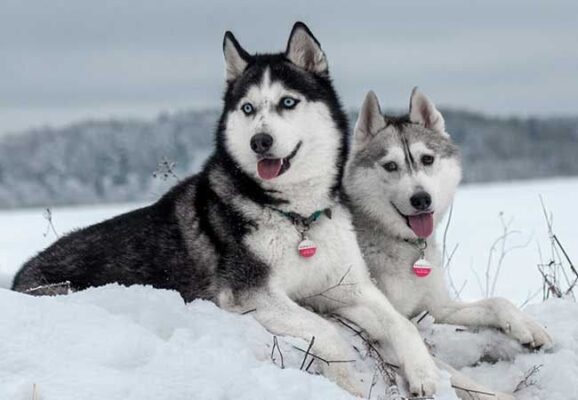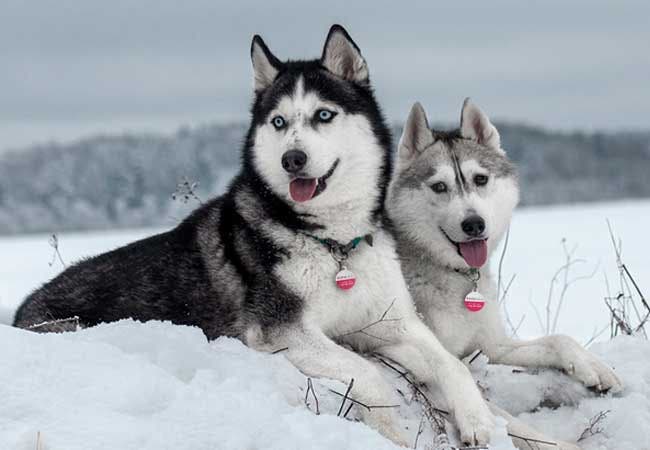Siberian Husky – The Majestic and Energetic Arctic Companion
Siberian Huskies are renowned for their striking appearance, incredible endurance, and friendly temperament. Originally bred by the Chukchi people in Siberia for sled-pulling and companionship in harsh Arctic conditions, Huskies have captured the hearts of dog lovers worldwide. This comprehensive article explores the breed’s rich history, detailed physical characteristics—including size, weight, and life expectancy—temperament, care requirements, and common health considerations.

1. History and Origins
Siberian Huskies trace their origins to the Chukchi people of Northeast Asia, who used them as working dogs for pulling sleds over long distances in frigid, snowy landscapes. Known for their stamina and resilience, these dogs were essential for transportation, communication, and survival in the harsh Arctic environment.
When Huskies were introduced to North America during the early 20th century, they quickly gained recognition for their strength, speed, and striking appearance. Their friendly and outgoing nature helped establish them as popular companion animals and exhibition dogs. Today, Siberian Huskies are celebrated not only for their historical significance but also for their energetic spirit and captivating beauty.
2. Physical Characteristics, Size, and Lifespan
Siberian Huskies are medium-sized, athletic dogs known for their wolf-like appearance and piercing blue or multi-colored eyes. Their physical traits are well adapted for cold weather and high-endurance activities.
Key Physical Features:
- Head and Face: Huskies have a well-defined, wedge-shaped head with erect ears and expressive eyes that can be blue, brown, or a combination of both. Their striking facial markings add to their unique appearance.
- Coat: They possess a dense double coat that provides excellent insulation against cold weather. Their fur can come in a variety of colors, including black, gray, red, and white.
- Body Structure: With a strong, muscular build and a balanced body, Huskies are built for endurance and speed. Their agile frame and powerful legs enable them to cover long distances with ease.
Detailed Measurements:
- Height: Siberian Huskies typically stand between 20 to 23.5 inches (51 to 60 cm) at the shoulder.
- Weight: They usually weigh between 35 to 60 pounds (16 to 27 kg), with variations based on gender and individual build.
- Life Expectancy: With proper care, Siberian Huskies generally live between 12 to 15 years. Their longevity can be influenced by genetics, exercise, and overall health management.
These physical characteristics ensure that Siberian Huskies not only look magnificent but also possess the stamina and resilience required for rigorous outdoor activities and cold-weather endurance.
3. Personality and Temperament
Siberian Huskies are well-known for their friendly, outgoing nature and remarkable independence. Their temperament makes them excellent family pets and active companions, though they do require proper training and socialization.
- Friendly and Sociable: Huskies are typically very social dogs who enjoy interacting with people and other dogs. They thrive in a family environment and are known for their gentle and playful nature.
- Energetic and Adventurous: As working dogs with a history of pulling sleds, Siberian Huskies have high energy levels and need plenty of exercise. They love running, hiking, and engaging in outdoor adventures.
- Independent but Intelligent: While they are intelligent and can learn quickly, Huskies also have an independent streak. This means that consistent, positive training methods are essential to guide their behavior effectively.
- Vocal and Expressive: Huskies are known for their distinctive vocalizations, which can include howling and playful “talking.” This expressive nature adds to their charm but may require training to manage in a home environment.
- Curious and Mischievous: Their inquisitive minds and high energy levels can sometimes lead to mischievous behavior if not provided with adequate physical and mental stimulation.
Their balanced personality makes Siberian Huskies excellent companions for active individuals or families who can provide the exercise and engagement they need.
4. Care and Training
4.1. Nutrition and Feeding
A balanced diet is critical to maintaining the health and performance of a Siberian Husky:
- High-Quality Diet: Choose dog food that is high in protein and contains essential fats, vitamins, and minerals. Formulas designed for active, medium-sized breeds are ideal.
- Portion Control: Ensure appropriate portion sizes based on your Husky’s age, weight, and activity level to prevent obesity while providing enough energy for daily exercise.
- Feeding Schedule: Establish regular feeding times and monitor their diet to ensure they receive consistent nutrition throughout the day.
4.2. Exercise and Activity
Siberian Huskies require ample physical and mental stimulation to stay healthy and happy:
- Daily Exercise: Aim for at least 60 to 90 minutes of exercise each day. Activities like running, hiking, or engaging in sled-pulling games are perfect for this breed.
- Mental Stimulation: Provide puzzle toys, training sessions, and interactive games to challenge their intelligent minds. Regular mental stimulation can help prevent boredom and destructive behaviors.
- Outdoor Adventures: Given their origin as sled dogs, Huskies thrive in outdoor environments. A securely fenced yard or regular access to open spaces is ideal for their exercise needs.
4.3. Training and Socialization
Early training and socialization are essential for harnessing the Siberian Husky’s energy and independent nature:
- Positive Reinforcement: Use treats, praise, and play to encourage desired behaviors. Consistent, positive reinforcement is the most effective method for training Huskies.
- Obedience Classes: Enroll in obedience training classes to establish basic commands and improve overall discipline. Early socialization with other dogs and people is also crucial.
- Patience and Consistency: Due to their independent streak, Huskies may be less inclined to follow commands compared to some other breeds. Patience and consistency are key in achieving successful training outcomes.
5. Health Considerations
While generally healthy, Siberian Huskies are predisposed to certain health conditions that require proactive care:
- Hip Dysplasia: As with many medium to large breeds, hip dysplasia can be a concern. Regular veterinary check-ups and maintaining a healthy weight can help minimize the risk.
- Eye Conditions: Huskies can be prone to eye disorders such as cataracts and progressive retinal atrophy. Routine eye examinations are important for early detection.
- Skin Conditions: Their dense coat may require occasional attention to prevent skin issues, particularly in extreme weather conditions. Regular grooming and bathing can help maintain healthy skin.
- Thyroid Issues: Some Huskies may develop thyroid imbalances. Routine health screenings and consultations with your veterinarian can help monitor and manage these conditions.
- General Preventive Care: Regular veterinary visits, a balanced diet, and appropriate exercise routines are essential in ensuring your Husky enjoys a long, healthy life.
6. The Role of the Siberian Husky in Society
Siberian Huskies have evolved from working sled dogs to popular family pets, yet they retain many of the characteristics that made them invaluable in harsh Arctic conditions:
- Family Companions: Their friendly and outgoing nature makes them excellent companions for active families and individuals who enjoy outdoor activities.
- Working Dogs: Many Huskies still participate in sled racing and other competitive sports, showcasing their remarkable endurance and strength.
- Show Dogs: Their striking appearance and unique personality have made them favorites in dog shows, where they are celebrated for both beauty and performance.
- Therapy and Service Roles: With proper training, Huskies can also serve as therapy dogs, providing emotional support and companionship in various settings.
Their adaptability and enduring spirit ensure that Siberian Huskies continue to be cherished by dog enthusiasts around the world.
7. Conclusion
The Siberian Husky is a breed that perfectly combines stunning looks, high energy, and a friendly, independent spirit. From their origins as indispensable sled dogs in the Arctic to their current role as active family companions, Huskies embody a unique blend of endurance, intelligence, and charm. Detailed physical characteristics—standing between 20 to 23.5 inches tall, weighing 35 to 60 pounds, and boasting a life expectancy of 12 to 15 years—underscore their suitability for active lifestyles and outdoor adventures.
If you are looking for a striking, energetic, and friendly companion who thrives in an active environment, the Siberian Husky is an excellent choice. With proper nutrition, regular exercise, consistent training, and proactive health care, a Siberian Husky can bring boundless energy, loyalty, and a touch of wild beauty to your life.


